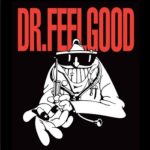 To paraphrase rock snapper Allan McKay, ‘in the unfortunate event of Armageddon, the only survivors will be rats, ants and the Technics 1200 record turntable. And Dr. Feelgood.’
To paraphrase rock snapper Allan McKay, ‘in the unfortunate event of Armageddon, the only survivors will be rats, ants and the Technics 1200 record turntable. And Dr. Feelgood.’
Starting out from Canvey Island in 1971, much has been made of the ‘no original members’ thing over the years. But you can trace the ‘blood line’ through this band going Way Back. As members have left or died, they’ve been replaced. Nothing ‘tributey’ about that. That’s reality. That, in part, is why I published “Rock ‘n’ Roll Twilight” in the first place. Bass man Phil Mitchell and drummer Kevin Morris have been with them since 1983, and so both recorded and toured extensively with main man Lee Brilleaux. Guitarist extraordinaire Steve Walwyn has been with the band since 1989; and even relative ‘newbie’, vocalist and harp player Robert Kane has fronted the Feelgoods for over 20 years, celebrating his 1000th Dr. Feelgood gig as long ago as 2007.
So let’s have none of that ridiculous sniffiness. As George Michael once said, ‘listen without prejudice’ (though admittedly that didn’t turn out well).
First though, a bit of a larff.
John Otway and Wild Willy Barrett first entered my flat by stealth when in 1977 Polydor Records sent me a copy of a single called “Really Free”. Like many record labels they were desperately casting around for ‘punk’ acts to sign in ’76/77 and picked this lot up from Pete Townsend’s Track Records label as they were basically taking what amounted to a scattergun approach but amongst the dreck this decidedly odd little single stood out. We gave it some plays, radio picked up on it and within what seemed like five minutes the duo were ‘On Top Of The Pops’ in time-honoured fashion and it became a ‘proper’ top 40 hit in the days when that meant Selling Stuff. The only problem being that as far as his musical partner is concerned, John Otway is a Complete Prat. A most unlikely ‘pop star’, he took the fast route back to obscurity by winning an international gurning award on Top of the Pops, and famously making a complete ass of himself by unsuccessfully attempting to hurdle a PA stack on BBC 2’s ‘The Old Grey Whistle Test’ TV show and ending up with his knackers in a splint. It could have been A Lot Worse.
He then proceeded to pay for the rest of his ticket back to nowhere by releasing a full-on, big-production ballad, “Geneve”, which completely stiffed despite the record company spending eye-watering amounts of money on promoting it (and record companies don’t forget that sort of error of judgment in a hurry) and, to further compound spectacular failure, not telling his musical partner WWB that he had neglected to give him a ‘name check’ and it was in effect a solo record for no other reason than that he did SO want to be a ‘proper’ ‘pop star’. Mr. Barrett was on his way to a gig at the time with Mr. Otway when he heard it introduced on the radio. Strangely enough, he didn’t turn up to play the gig that night and the duo had the first of about 27 ‘splits’ thus far.
Back on stage together and both now either 70 or pushing it, on first appearances it is difficult to resist the conclusion that for some strange reason the ghost of author Roald Dahl has dyed his hair black and decided to tour with a grumpy version of half of Chas and Dave. And a Wheelie Bin. More later.
However, be that as it may, we are treated to a spirited gallop through ‘Louisa on a Horse”, their second single, sort of accompanied by a scraping, raking fiddle contribution by Barrett. This is followed by ‘The Hit’, which they make a monument out of, informing the assembled ‘this is as good as it gets – the bar is over there!’ and stopping part way through in order to drag five minutes out of the thing. By which time, half the audience are in hysterics and the other half are wide-mouthed and not necessarily in admiration.
“Beware of the Flowers” features Barrett on Wheelie Bin. When he wishes to make a contribution to proceedings he opens a brown wheelie bin which is strategically placed by his side which contains an FX machine from which emanates ‘rock guitar’ noises and other things, brilliantly timed with deceptively well-rehearsed comedy in the opening and closing of the bin (no, really! Very funny indeed. I will take the recyc out with some trepidation after this.)
They then make a spirited but ill-judged attempt to pay tribute to Rolf Harris’s “Two Little Boys”. I always thought seeing as Rolf had done a cover of Led Zeppelin’s “Stairway to Heaven”, Robert Plant and his mates might have at least returned the compliment by having a shot at said tune, but no. It is left to Otway and Barrett to right a historical wrong. Which isn’t a good thing, necessarily…
Otway then explains the reasons for the 27th split being Barrett’s refusal to play encores so the audience are encouraged to go for the compromise which is that they’d stay onstage whilst the audience make a whole load of noise and then they’d do “Geneve” as a ‘not’ encore. During which shenanigans Barrett takes a tenon saw and tries to cut the acoustic he’s playing in half (whilst playing it), then assaulting it with a hammer before stomping all over it for no apparent reason. Then and once again inexplicably a set of bagpipes disguised as Bagpuss come into play. Otway then sweeps off like the ‘star’ he ‘is’ and Barrett is left onstage to offer the mangled cheapo acoustic, which cost him £30, to the first member of the audience to stump up £33 (inc artistic ‘tax’) as a charitable donation at the merch. Ermm…….I was only massively entertained. Never left a show which has Otway in it anything other than grinning like an idiot. And this was no exception. Folk meets pop meets rock meets country, somewhere around the crossroads marked English Eccentricity.
But let us not delay too long here as this is all about the Feelgoods. On the band march at the allotted time, to a Friday night ‘full house’ welcome and straight away you can see they’ve clocked this could be Very Good Indeed. There is already a sense that we’re Having It.
We start with a whole bunch of ‘oldies’; “Drives Me Wild” as a ‘sighter’ whilst they bring Robert Kane’s mike forward a bit in the mix, “No Mo Do Yakomo”, I Can Tell” where Steve Walwyn lets that flamethrower Telecaster loose for the first time tonight, “Been Down So Long” and “Down by the Jetty” which once again reminds the assembled what a wealth of great R and B songs this band have in their locker which very rarely troubled the UK singles chart (but goodness me, they shifted some albums).
The next segment of the evening’s proceedings features Steve Walwyn on slide guitar with some great blues vocals and harp stabs by Robert Kane. This guy is a great rock singer by any measure but can he sing the blues….it is no surprise he was with The Animals 2 before he joined the Feelgoods. Anyone who at any point found himself in Eric Burdon’s shoes is, we can perhaps agree, none too dusty, but the band reel off a vinegar version of Elmore James “Dust my Broom”, “Rollin’ and Tumblin” and of course whilst you’ve got the correct weapon to hand, “Back In The Night”, their mid-seventies jukebox shaker which introduced a whole bunch of Brit rock fans to the Joy of Slide, if Rory Gallagher hadn’t already done so.
This, then, is the first of the ‘juke box hits’ section of the show as we gallop in rapid sequence through a jumping, pulsating “Roxette”, taking a few minutes out for a slow blues band showcase in “Shotgun Blues” where all the band members show what they can do. Steve Walwyn makes a claim to be the best guitarist Dr Feelgood ever had (and not only the longest-serving) at this point (controversial, I know; when you’re talking Gypie Mayo and Wilko Johnson as the primary contenders) and Phil Mitchell’s rumbling, sinuous bass is absolutely killer here, and then we’re off to shake that jukebox again as we blast through a rabble-rousing if slightly misfiring version of “Milk and Alcohol”, and a spirited rip through the thoroughly ‘wired’ “She’s A Wind Up” followed by the sharp, ‘all elbows and knees’ jerkiness of “She Does It Right”.
Everything they do has that precision of the heavily-gigged professional rock act. This is no occasional run out, or a 20-date travelling circus. This is what they do and what this band has done, in venues of this size and bigger and smaller, since 1971. That’s nearly 50 years. And I shudder to think how many gigs the band has done in that time.
After that and in a perfectly-judged set there’s a mélange of what should have been a massive radio drivetime hit “Going Back Home”, “Down At The Doctors” (Got to number 48 on the UK singles chart…….hellowwww…..!) “Gimme One More Shot” and they’re off.
And of course they’re not going to get off that lightly. We do indeed get one more shot and it’s a spectacularly dense and intense “Mad Man Blues” followed by the flip side of Roxette back in 1974, the ultimate encore machine, “Route 66” and then they ARE gone.
Never mind all the sniping about who’s who. These lads are rapidly becoming a national treasure in a world of phonies and one-trick-ponies. From the greasy sleaze of the ‘sneaking out the back door with a grin’ stories to the workaday, careworn, bluesy lyrics, from the red hot and rocking juke-box smashes to the smouldering, powerful blues workouts, this is the way to celebrate the end of the working week alright. Need a shot of Rhythm and Blues? Go see the Doctor. He might be considering retiring. Or he might, in some incarnation, just go on for another hundred years. Because Dr. Feelgood is a sort of collective; a sort of ‘idea’, born largely out of the energy and vision and drive of one Lee Brilleaux. But despite the fact that Lee isn’t around to see how well his insistence the band carried on after his death worked out……why stop now?
Postscript: And in the pub across from the venue afterwards, the esteemed and venerable Nook, we fell across the lucky man who is now the proud possessor of a sawn – off acoustic guitar. They didn’t event throw in the tenon saw for his £33.
Reckons it is going straight on e Bay.
Ok, call me obsessive if you like but as well as listening to a lot of albums and going to as many gigs as I can, I also read the odd book or two about music and popular culture and many of those are worth sharing with anyone who checks out MusicRiot regularly. This list was difficult to pin down to five from the start, but it became even more difficult on Christmas Day when I was given a copy of the Donald Fagen memoir/tour diary/article compilation, “Eminent Hipsters”. So I guess that’s a pretty good place to start.
“Eminent Hipsters” – Donald Fagen
 Where do I start with Donald Fagen? With Walter Becker, he was half of one of my favourite 70s bands, Steely Dan and then went on to release the classic solo album, “The Nightfly” in 1982, followed (not too closely) by “The Kamakiriad” in 1993. You’ve probably guessed by now, I’m a bit of a fan. “Eminent Hipsters” is partly an explanation, through a series of articles, of the factors which influenced the Steely Dan sound (cool jazz, cop dramas and wise-ass comedians) and the Donald Fagen solo sound (science fiction and mid-century paranoia). If you love the music, you’ll be fascinated by these observations about its roots. The second part of this slim volume is devoted to Fagen’s diary from the 2012 “Dukes of September Rhythm Revue” tour which is, by turn, snarky, moving, insightful and downright hilarious.
Where do I start with Donald Fagen? With Walter Becker, he was half of one of my favourite 70s bands, Steely Dan and then went on to release the classic solo album, “The Nightfly” in 1982, followed (not too closely) by “The Kamakiriad” in 1993. You’ve probably guessed by now, I’m a bit of a fan. “Eminent Hipsters” is partly an explanation, through a series of articles, of the factors which influenced the Steely Dan sound (cool jazz, cop dramas and wise-ass comedians) and the Donald Fagen solo sound (science fiction and mid-century paranoia). If you love the music, you’ll be fascinated by these observations about its roots. The second part of this slim volume is devoted to Fagen’s diary from the 2012 “Dukes of September Rhythm Revue” tour which is, by turn, snarky, moving, insightful and downright hilarious.
Donald Fagen writes in an instantly-identifiable style betraying a debt to Raymond Chandler and Dashiell Hammett, which sneaks in when describing Audrey Hepburn in “Breakfast at Tiffany’s” as getting :”out of that cab on Fifth Avenue in a black dress and pearls in the early morning, I wanted to sip her through a straw”. It’s beautifully written and you can get through it in a few hours; it takes 170 pages to deliver a message that most rock biographies take at least five times as long to get over.
“Bedsit Disco Queen: How I Grew Up and Tried to be a Pop Star” – Tracey Thorn
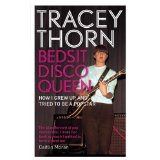 If Donald Fagen’s prose style is easily identifiable, then Tracey Thorn’s is even more so. I’m always impressed when musicians get this right (Peter Hook and Luke Haines also do it particularly well) and, from the first paragraph, this is pitch-perfect ‘Popstar Trace’. The book takes us from the Marine Girls beginnings through the EBTG false starts and eventual success to the beautiful Massive Attack vocals (I’m biased, but you should read about the origins of the modern classic, “Protection” here) and the worldwide Todd Terry-remixed success of “Missing”.
If Donald Fagen’s prose style is easily identifiable, then Tracey Thorn’s is even more so. I’m always impressed when musicians get this right (Peter Hook and Luke Haines also do it particularly well) and, from the first paragraph, this is pitch-perfect ‘Popstar Trace’. The book takes us from the Marine Girls beginnings through the EBTG false starts and eventual success to the beautiful Massive Attack vocals (I’m biased, but you should read about the origins of the modern classic, “Protection” here) and the worldwide Todd Terry-remixed success of “Missing”.
Tracey’s style is perfectly self-deprecatory; you never feel a hint of false modesty and the mentions of famous musicians are always very matter-of-fact, including the story about waiting to pick the kids up from school and being shouted at by George Michael from a Range Rover. This is a wonderful memoir from a genuine pop star.
“Yeah, Yeah, Yeah: The Story of Modern Pop” – Bob Stanley
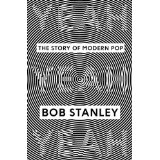 It’s obvious from the outset that this is actually a companion piece to the classic 2012 St Etienne album, “Words and Music”. The album was a voyage through the history of British pop music and the book is an extended verbal remix of the ground covered by the album. What’s equally obvious is that Bob Stanley is both an enthusiast and an insider, which gives him a unique perspective on his subject. He aims to show the links between different styles using not just the music, but also sociological and technological developments. If you’re interested in the history of pop music and you’ve done a bit of research, you might disagree with some of his pronouncements, but it’s a big book and you’ll probably agree with ninety per cent of them.
It’s obvious from the outset that this is actually a companion piece to the classic 2012 St Etienne album, “Words and Music”. The album was a voyage through the history of British pop music and the book is an extended verbal remix of the ground covered by the album. What’s equally obvious is that Bob Stanley is both an enthusiast and an insider, which gives him a unique perspective on his subject. He aims to show the links between different styles using not just the music, but also sociological and technological developments. If you’re interested in the history of pop music and you’ve done a bit of research, you might disagree with some of his pronouncements, but it’s a big book and you’ll probably agree with ninety per cent of them.
The book takes the first NME chart in 1952 as its starting point (which is logical and not controversial) and the end of vinyl as a chart force in 1993 as its end point, when the first Number One singles not to have been released as a 7” single or (a few months later) on vinyl at all topped the charts (if you want to know what they are, you can buy the book ). It’s a slightly more controversial choice but still with a logical basis for someone who grew up in the age of vinyl. The book has an authority derived from Bob Stanley’s experience as a writer and member of a very successful pop group but never slips into the socio-cultural academic approach of, for example, Simon Reynolds. The theme that underpins everything else in this book is that Bob Stanley is still a fan who wants you to come round and listen to his records, and that makes this an unmissable book.
“Here Comes Everybody: The Story of the Pogues” – James Fearnley
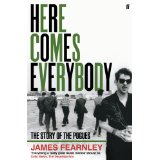 I’ve always been a fan of the “inside story” biography, particularly those that aren’t ghost-written attempts at cultural revisionism. This memoir by James Fearnley is, at times, brutally and crushingly honest about members of The Pogues and he doesn’t spare himself either. The book begins by setting the scene with Shane MacGowan’s departure from the band in 1991 before moving back to Fearnley’s initial meeting with MacGowan at an audition for The Nips in 1980.
I’ve always been a fan of the “inside story” biography, particularly those that aren’t ghost-written attempts at cultural revisionism. This memoir by James Fearnley is, at times, brutally and crushingly honest about members of The Pogues and he doesn’t spare himself either. The book begins by setting the scene with Shane MacGowan’s departure from the band in 1991 before moving back to Fearnley’s initial meeting with MacGowan at an audition for The Nips in 1980.
The book is a (mainly) unsentimental account of the rise and fall of The Pogues from the viewpoint of someone close enough to see everything but with enough distance to retain some objectivity. From the chaotic managerless beginnings through the unpopular but successful stewardship of Frank Murray, the story is underpinned at all times by MacGowan’s unpredictability and seemingly random self-destructive urges. James Fearnley tries very hard to balance the singer’s inexcusable behaviour against the genius of the songs, but it’s up to you if you buy that line; I certainly don’t. My only criticism is that James Fearnley spends a little too much time trying to emphasise the fact that he’s a writer and occasionally introduces unnecessarily florid prose to prove it; putting that aside, it’s still a winner.
“Sounds like London: 100 Years of Black Music in the Capital” – Lloyd Bradley
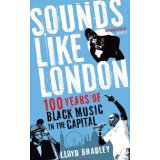 Bear with me for a minute here; this will all make sense presently. Earlier this year I read “How Soon is Now?: The Madmen and the Mavericks who made Independent Music 1975-2005” by Richard King. It’s a very good book and a must for geeks like us, but it attracted a lot of criticism because it didn’t touch on the black music scene. Richard King was even accused, pathetically, of racism in some quarters; you might even have read about it. Personally, I prefer to read authors who write about subjects they understand and that really inspire them; if Richard King didn’t have the expertise, contacts or inspiration to write about the black music scene, then Lloyd Bradley certainly did.
Bear with me for a minute here; this will all make sense presently. Earlier this year I read “How Soon is Now?: The Madmen and the Mavericks who made Independent Music 1975-2005” by Richard King. It’s a very good book and a must for geeks like us, but it attracted a lot of criticism because it didn’t touch on the black music scene. Richard King was even accused, pathetically, of racism in some quarters; you might even have read about it. Personally, I prefer to read authors who write about subjects they understand and that really inspire them; if Richard King didn’t have the expertise, contacts or inspiration to write about the black music scene, then Lloyd Bradley certainly did.
The title is a little misleading; there’s very little about pre-1950s black music, and it also deals with regional English offshoots from the London scene but those aren’t criticisms, just observations. The reason for the comparison with Richard King’s book is that one of Lloyd Bradley’s recurring themes is that black British music has always developed and prospered healthily out of the mainstream when produced and distributed independently.
Once the book reaches the point where Lloyd Bradley can introduce interviews with the players who made black British music happen (the steel pan players, the jazzers, the sound system pioneers, the Britfunk players and the mainstream crossovers Eddy Grant, Janet Kay, Jazzie B and the rest), the narrative really takes off with stories of the sound systems and records being sold out of the back of a car and distributed around the country in the same way. Lloyd Bradley takes us through calypso, ska, reggae, lovers rock, dub, britfunk, 98 bpm, trip hop, jungle, d’n’b, UK garage, dubstep and grime along with a host of short-lived one-way streets with an unassuming and easy authority that is very seductive. If you want an introduction to black British music, this is the book for you.
OK, spoilers alert; I’ve relented. I’ll tell you that the chart-toppers Bob Stanley refers to in 1993 and 1995 respectively are Culture Beat’s “Mr Vain” and Celine Dion’s “Think Twice”, but you should still read the book. Actually you should read all of these books.


